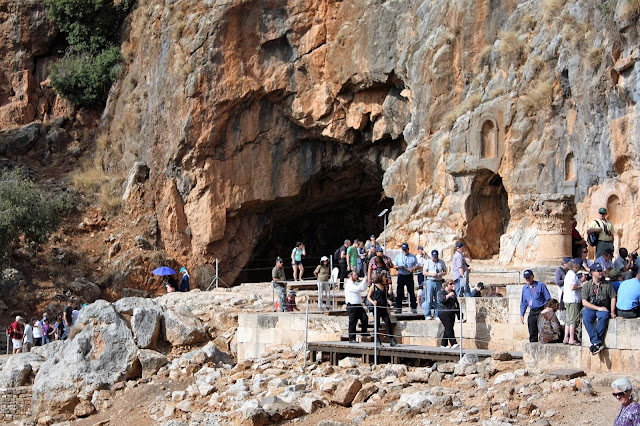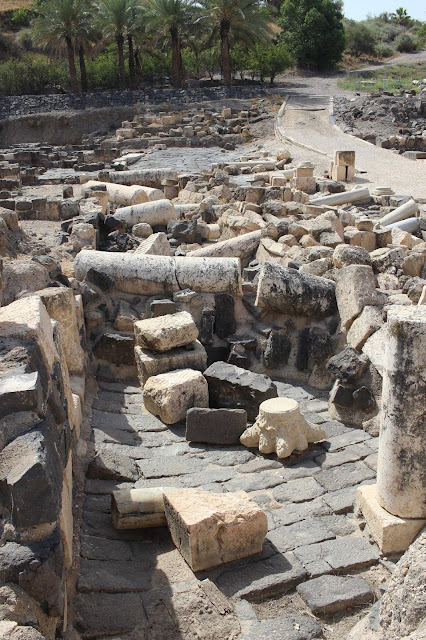Day 19
My day started off with a nail biter. I thought I left my camera in the dining room at the hotel. I made the right phone calls but it didn't look hopeful. As I prayed through the forgetfulness of my action, I realized that maybe it was a day for listening and watching instead of taking pictures. So, instead of lamenting over the lost camera I just followed the group around and tried to absorb all I saw and heard. It was awesome...I used my phone to take a few shots.
When I got back to the hotel, after interrogating the staff and searching the areas I was in, I went back to my room. The camera was sitting on my desk. I had merely forgotten it! Thanks to the patient and concerned folks in our group and many thanks for the prayers from loved ones at home. God is good...I am forgetful!
So, the only pics I have for day 19 came from my phone.
Our first visit of the day was Hazor. Hazor predates many of the event in the Bible. It is situated just south of the Hulah Valley. It was considered highly strategic to the Egyptians. By Joshua's time, it was one of the largest cities mentioned in the Old Testament. It was also one of three major cities destroyed at the end of the Exodus (Josh 11). The other two were Jericho and Ai.
 |
| The Hulah Valley was a major east/west trade route |
 |
| With a healthy supply of water, Hazor had a very sophisticated water system |
 |
| Sitting high on a hill, Hazor was easily defend-able and had formidable gates. This gate provided access form the lower city to the upper. |
We moved on the Tel Dan. The tribe of Dan was originally allotted land to the west of Benjamin and Judah. Dan was unable to overpower and evict the Philistines and decided to move to the very northern end of Canaan where they took the city of Laish.
 |
| Dan is near the headwaters of the Jordan River. |
Dan's mistake was two-fold. They did not act on the promise of the land that was allotted to them, and they occupied land that was not given to them.
When King Rehoboam dramatically raised taxes, Jeroboam led the ten northern tribes, including Dan, to separate from the southern tribes (Judah and Benjamin). Since the northern tribes were cut off from Jerusalem, they established Bethel and Dan as centers for worship. Altars were set up in both towns in an effort to keep people from migrating south toward Jerusalem. Compromises were made to appease the people. It didn't take long for the worship to deteriorate into idolitry and pagan practices.
In an effort to offer a "yahweh-esque" type experience, a golden bull was fashioned to represent God.
Does this sound familiar?
Soon, the people were worshiping the bull instead of God. This is exactly why we have the second commandment. We are never to make a visual representation of God. God defines His image, not man.
Caesarea-Phillipi, our next destination, was originally named Paneas and/or Bonneas. There was a grotto in Caesarea-Phillipi that was believed to be an entrance to Hades.
 |
| The grotto and temple site. This picture is from oor 2013 trip. |
In Mark 8, on His way to Caesarea-Phillipi, Jesus heals a blind man in Bethsaida (Mark 8:22). The healing occurs in two stages. Why?
Jesus is about to enter Caesarea-Philippi and tell the disciples He is going to Jerusalem to die. They won't understand. Very much like the blind man, they see something is happening, but they can't see it clearly. In healing the blind man in two phases, Jesus is showing the disciples that their understanding of what is about to happen will not be complete at first, but a more clear perception will come later. Their understanding will come in two phases.
We spent the rest of the afternoon on the Golan Heights. These mountains lie on the eastern shore of the sea of Galilee and were formerly occupied by Syria who took advantage of their close proximity to Israel. Mortar and missile attacks from Syrai became so common, there is a generation of school children known as Miklat Kids. These are kids that grew up in underground shelters (miklats) because living above ground was too dangerous. The Golan Heights were taken by Israel during the war in 1967.
 |
| The Syrian border is literally a mile or so from the peeks of the Golan Heights. Security is tight. |
 |
| Tanks and armored vehicles are common sights on and off the roads. |
Day 20
I woke up to the alarm this morning and couldn't get out of bed. While I was struggling, I found a note pinned to my blanket. It was from my legs,
Dear John, We are sorry to inform you that we are no longer interested in working for you. We are in the process of interviewing for another owner that will take better care of us and give us a day off.
After some pretty intense negotiations, I was able to convince them that this was only a temporary situation and got them to come back to work.
Close one. I've never been fired by a body part before.
Me, my legs and the group left our hotel on the east side of the Sea of Galilee this morning. It was a beautiful place to stay.
Traveling south, our first stop was Beth Shan, also known as Scythopolis. This huge city, located at the western tip of Mount Gilboa in the Jezreel Valley. This was where Saul's body was put on display by the Philistines after he died in battle (1 Sam 31).
After the Romans occupied the region, they transformed Beth Shan into a beautiful Roman city.
 |
| A model of the Roman era city |
 |
| This was a spa. The stone pillars held up a floor. They were heated, then water poured over them to warm the floor and create steam. |
 |
| A latrine for the upper crust. Boy! They had it made! |
 |
| Aaron, Ian, Brian and Joey demonstrate hoe the latrine was used. |
 |
| A main thoroughfare. The hill in the background had a temple on the top. |
 |
| A major earthquake destroyed this city and Hippus in 749 AD |
 |
| A public latrine for the common folk |
 |
| Pomegranate trees |
Mount Gilboa, overlooking the Jezreel Valley, was our next stop. This was the location of Gideon's Spring (Judges 7).
We moved about an hour south, into the Judean Wilderness and visited Al Yahud, a baptismal site on the Jordan River on or near where John the Baptist was baptizing.
 |
| Jordan can be seen through the palm trees. |
 |
| There steps into the river. About 25 feet away on the other side of the Jordan River, is a similar Jordanian facility. |
 |
| A Catholic Chapel on the Jordan side |
On the way back to our hotel near Jerusalem, we stopped at a familair rest stop and had some fun.
 |
| Daniel making like a Bedouin |
 |
| Anne conquering the dessert |
 |
| Becky taking it in stride...get it? Stride? |
 |
| Joey looking like a CIA, special forces camel-jockey. |
 |
| Our newest friend, for only 10 shekels. He likes us! |
Tomorrow, we go on an archaeological dig!







































I think Kelly's humor is rubbing off on you vis a vis the lavatory photo...
ReplyDelete